You can easily test your dried herbs' strength through several reliable methods. Start with a visual check – vibrant colors indicate potency while brown or grey suggests degradation. Crush herbs between your fingers to release essential oils and assess aroma intensity; strong scents mean robust flavor. Check moisture content by ensuring herbs feel crumbly and rustle when touched. Store them in airtight dark glass containers and monitor color changes over time. Additional tests include light transmission analysis, density evaluation, and antioxidant activity measurements. These proven techniques will help you maximize your herbs' culinary and medicinal benefits, with even more precise methods available for detailed assessment.
Visual Color Assessment
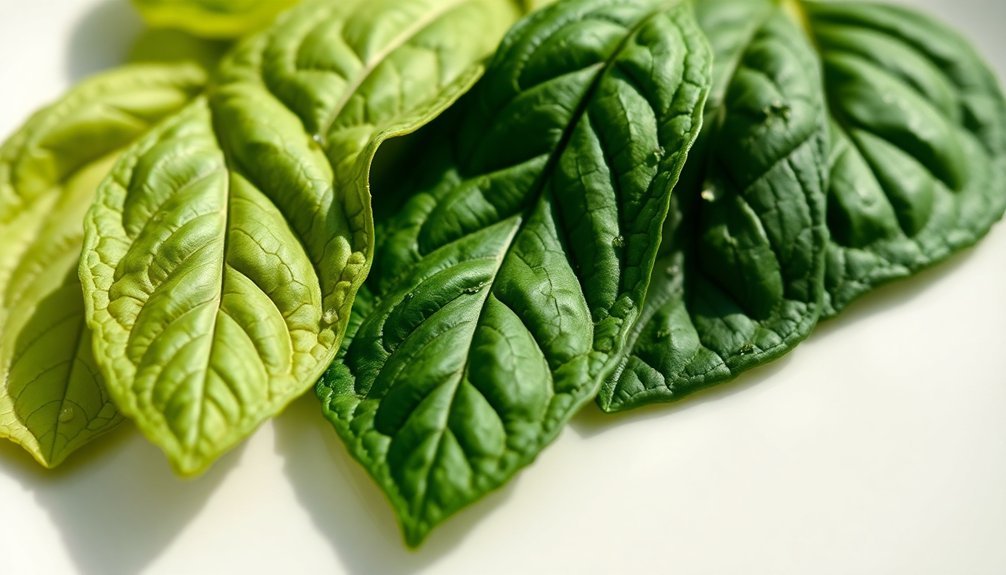
Most experienced herbalists begin their quality assessment with a simple yet effective visual inspection. You'll want to look for vibrant colors that closely match those of freshly picked herbs.
If you're examining dried herbs that appear brown, grey, or markedly faded, they've likely lost their potency and won't provide the desired therapeutic effects. The importance of proper identification is critical, as lack of quality control can significantly hinder the acceptance and effectiveness of herbal medicine.
You can easily evaluate herb quality by comparing the dried specimen to its fresh counterpart. Each herb should maintain its characteristic color profile – for instance, dried basil should remain distinctly green, not yellow or brown.
If you notice notable color deviations from what's expected, it's a clear sign of poor quality or improper processing.
Proper storage plays an essential role in maintaining herb color and potency. You'll need to keep your herbs in airtight brown glass containers and store them in a cool, dark place.
If you've stored herbs in clear containers or exposed them to sunlight, they'll likely show signs of color degradation.
For more precise identification, you can use colorimetric analysis tools, which help authenticate herbs based on their specific color characteristics.
Crush and Crumble Test
Beyond visual assessment, a hands-on approach reveals even more about your dried herbs' quality. The crush and crumble test is a reliable way to determine if your herbs have reached ideal dryness for storage and use. When you squeeze dried herbs between your fingers, they should crumble easily, and stems should snap when bent. Early morning harvest produces the best herbs for drying and testing.
Different drying methods yield varying timeframes for achieving the perfect crumble:
- Dehydrator: 1-3 hours at 90-100°F
- Air-drying: 5-10 days depending on environment
- Microwave: A few minutes between paper towels
- Oven: 30-75 minutes with door cracked open
Once your herbs pass the crumble test, you'll want to store them properly to maintain their potency. Keep them whole rather than pre-crushed, as this preserves their flavor and aroma longer.
You'll get the most impact by crushing them just before use. Remember, dried herbs are 3-4 times stronger than fresh ones, so you'll only need about 1/4 to 1/3 of the amount called for in recipes using fresh herbs. For the brightest flavor, add them toward the end of cooking.
Aroma Intensity Check
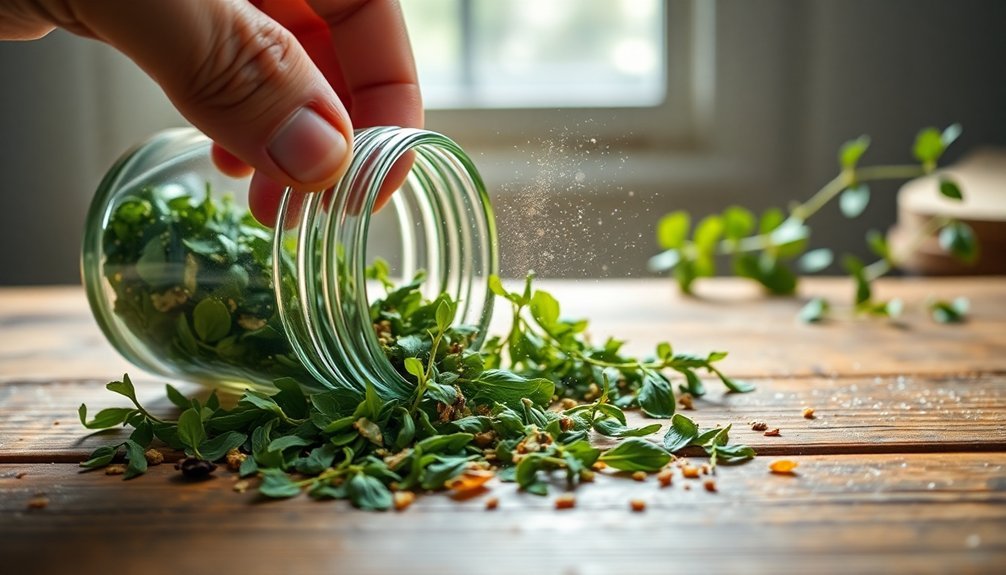
To check your dried herbs' potency, take a small amount and crush them between your fingers to release their essential oils and aromatics.
Hold the crushed herbs close to your nose and inhale deeply to assess if they maintain their characteristic fresh smell.
You can also test the aroma's strength by holding the herbs at different distances from your nose – high-quality herbs should be detectable from several inches away.
A musty or stale aroma indicates the herbs have likely degraded and should be replaced.
Crush and Sniff Test
The crush and sniff test serves as a reliable method to evaluate the strength of your dried herbs. Start by taking a small amount of the herb and crushing it in your clean, dry hand to release its essential oils and natural fragrance.
You'll want to perform this test in an environment free from competing odors to get the most accurate assessment.
When you're checking the aroma intensity, you should notice an immediate, robust scent. If the herb's fragrance is weak or doesn't emerge quickly, it's likely lost its potency. Remember that whole spices like peppercorns need to be crushed or broken to properly release their aroma.
Here's what you're looking for during the test:
- Strong, distinctive aroma that releases immediately upon crushing
- Crisp, dry texture without any moisture or softness
- Vibrant color appropriate to the specific herb
- Clean, fresh smell without any musty or stale notes
You'll want to perform this test annually and adjust your cooking measurements based on the herb's strength.
For maximum flavor in your dishes, lightly crush dried herbs before adding them to your recipes, and store them in airtight containers in a cool, dry place.
Aroma Distance Assessment
While the crush and sniff test provides initial insights, performing an aroma distance assessment offers a more detailed evaluation of your dried herbs' potency.
To conduct this test, you'll want to work in a well-ventilated room where you can accurately gauge the herb's aromatic reach.
Hold the dried herb at different distances from your nose, starting at arm's length and gradually moving closer. Note the point at which you first detect the characteristic aroma. Strong, properly dried herbs should emit noticeable scents even from several inches away. If you can't smell the herb until it's directly under your nose, it may have lost significant potency.
Between assessments, you can reset your olfactory senses by smelling roasted coffee beans. This helps maintain accuracy as you evaluate multiple herbs or samples.
Pay attention to specific aroma notes – whether they're woody, citrusy, or peppery – as these indicate the presence of essential volatile compounds. Fresh, potent dried herbs should retain their characteristic smell without any musty or stale undertones.
If you're testing multiple herbs, remember that each has its own unique aroma threshold and signature scent profile.
Moisture Content Measurement
Measuring moisture content in dried herbs stands as a critical step for ensuring proper preservation and potency. You'll need to achieve a 10% moisture content level to maintain your herbs' quality and prevent mold growth. By understanding different measurement methods, you can consistently produce properly dried herbs.
- Tactile Method: You'll know your herbs are ready when they make a rustling sound and feel crumbly to touch. While this method isn't precise, you'll develop accuracy through experience.
- Microwave Testing: Start by weighing your herbs, then microwave them in short bursts until the weight stops changing. You can calculate moisture content by comparing initial and final weights.
- Air-Drying Technique: Set up your herbs in a low-humidity area with good air circulation. Use paper bags with holes to protect from dust while maintaining airflow.
- Quantitative Approach: For precise results, weigh your samples regularly during the drying process. Calculate moisture content using the formula: (moisture mass / total starting mass) x 100.
Choose your measurement method based on your needs – tactile evaluation works well for small batches, while quantitative measurement provides the most accurate results for larger operations.
Light Transmission Analysis
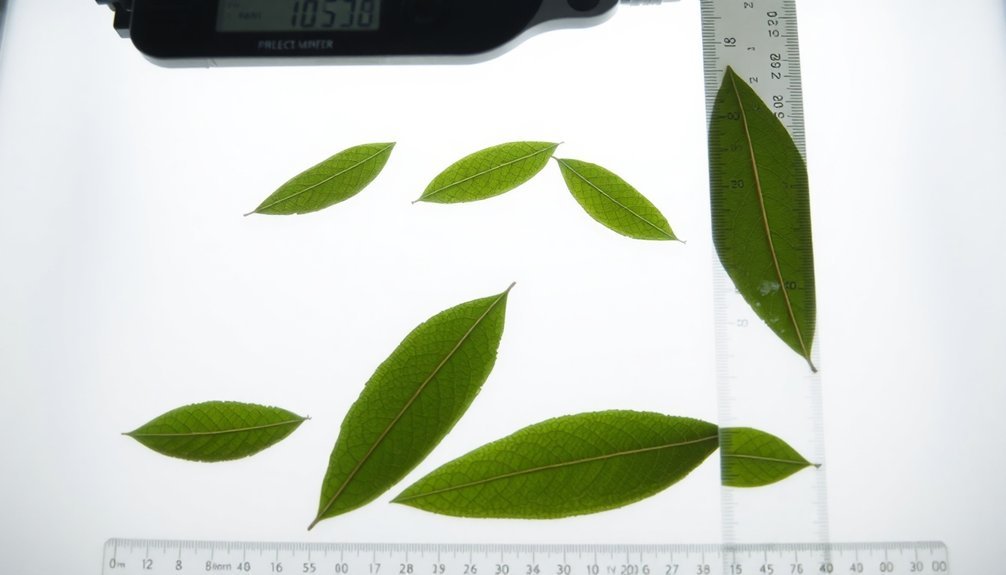
You can accurately assess dried herb strength by measuring the color intensity through light transmission analysis, which reveals the concentration of active compounds.
Light absorption testing methods help you determine the level of essential oils and other bioactive components retained during the drying process.
Using a spectrophotometer or similar device, you'll get precise measurements of how much light passes through your herb samples, indicating their potency and quality.
Measuring Herbal Color Intensity
Through the use of specialized equipment like spectrophotometers and integrating sphere devices, light transmission analysis offers a precise way to evaluate dried herb quality.
You'll need to prepare your samples uniformly by carefully grinding or cutting them to similar sizes while avoiding over-fragmentation. It's essential to distribute the material evenly on your measurement device and maintain controlled environmental conditions throughout testing.
To effectively measure herbal color intensity, you'll want to follow these essential steps:
- Use a spectrophotometer to measure light transmission across multiple angles, simulating natural lighting conditions
- Test samples in both dry and wet conditions to account for real-world scenarios
- Calculate hemispherical transmission using the double-beam method
- Document transmission levels across UV, PAR, and NIR solar radiation spectrums
You can optimize your drying techniques by analyzing the transmission data and comparing results under different conditions.
This information helps you preserve essential oils and maintain herb quality. By following standardized protocols like NEN2675:2018 +C1, you'll guarantee consistent measurements that contribute to your quality control process.
Light Absorption Testing Methods
Light absorption testing stands out from among the most reliable methods for evaluating dried herb quality. You'll need a spectrophotometer to measure how much light passes through your herb sample, which directly indicates its concentration and potency.
To perform this test, you'll first prepare your dried herb sample by dissolving it in an appropriate solvent. Place the solution in the spectrophotometer, which will shine light through it at specific wavelengths. The device measures both the initial light intensity (Io) and the intensity after it passes through your sample (It). Using the Beer-Lambert Law, you can calculate the exact concentration of active compounds in your herbs.
For the most accurate results, you'll want to take measurements under both dry and wet conditions, as moisture can affect light transmission. Make sure to include control measurements by directing light at an empty sample holder.
You can analyze your data using statistical tools to determine significance. Pay attention to changes in absorbance values – higher absorbance often correlates with stronger herb potency. Remember to account for variables like condensation and different angles of light, which can affect your readings.
Essential Oil Content Testing
Testing the essential oil content of dried herbs requires both sophisticated laboratory methods and practical sensory evaluation.
You'll find that professional labs use advanced techniques like gas chromatography and mass spectrometry to analyze the chemical composition and detect any contaminants in your herbs' essential oils.
When you're evaluating essential oil content in dried herbs, consider these key testing approaches:
- Use the paper test by placing a small amount of crushed herb on white paper – if it's rich in essential oils, you'll notice a temporary translucent mark that shouldn't leave an oily residue.
- Conduct smell analysis by crushing the herbs between your fingers, noting the intensity and quality of the aroma that's released.
- Compare your samples with known standards to gauge relative potency and quality.
- Time the duration of the herb's aroma after crushing to assess oil concentration.
For best results, you'll want to test herbs that have been properly harvested and dried.
Remember to collect your herbs in mid-morning when essential oil concentrations peak, and verify they're completely free of surface moisture before processing.
If you're drying multiple varieties, label them clearly to maintain accurate testing records.
Density Evaluation Method
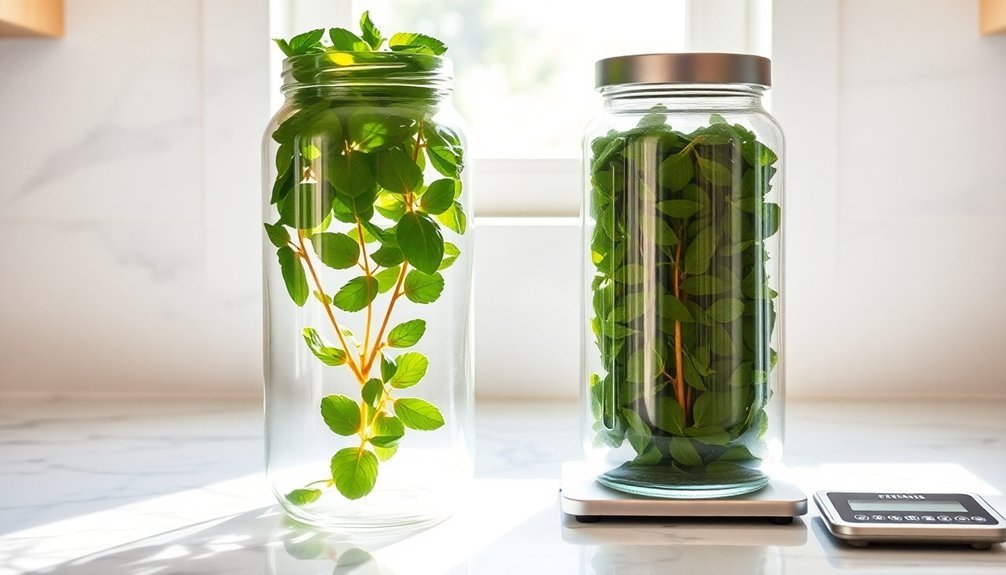
When evaluating dried herbs, the Density Evaluation (DE) method offers a systematic approach to assess their quality and potency. You'll need to establish a baseline and use quadrats or belt transects for accurate sampling, depending on the herb type you're testing.
To implement this method, you'll start by setting up multiple sampling units across your dried herb batch. Count individual plants within each quadrat, making sure you can clearly identify separate specimens. For smaller herbs, use smaller quadrats, while larger specimens require wider belt transects. You'll calculate density by dividing the number of individuals by the sampling unit area.
You'll want to maintain consistency in your measurements to guarantee reliable results over time. While this method works best for single-stem plants, it can be trickier with herbs that spread through vegetative reproduction.
Take careful height measurements alongside your density counts, as both factors contribute to overall herb quality assessment. Remember to document your baseline measurements carefully – you'll need these for comparing future batches and tracking changes in your herb's density characteristics.
This systematic approach helps you quantify and monitor your dried herbs' strength with scientific precision.
Storage Stability Assessment
Beyond density measurements, a thorough storage stability assessment provides key insights into your dried herbs' lasting potency.
You'll want to start by evaluating your storage conditions, making sure your herbs are kept in airtight glass containers away from direct sunlight. A cool, dark, and dry location with good air circulation will help maintain their strength over time.
To properly assess storage stability, follow these essential checkpoints:
- Examine color vibrancy – Your herbs should maintain their natural hue with minimal fading. If you notice significant discoloration or dullness, it's a sign of diminishing active compounds.
- Test aroma intensity – Open containers periodically to check for strong, characteristic scents. If you detect weak or musty smells, your herbs are losing their potency.
- Check texture consistency – Properly stored herbs should feel crisp and brittle. When leaves don't crumble easily or feel soft, they've likely been exposed to moisture.
- Monitor container integrity – Inspect your glass containers regularly for proper sealing, and make sure they're preventing any moisture buildup that could compromise your herbs' strength.
Regular stability assessments help you maintain quality control and make sure you're using herbs at their best potency.
Sensory Profile Comparison
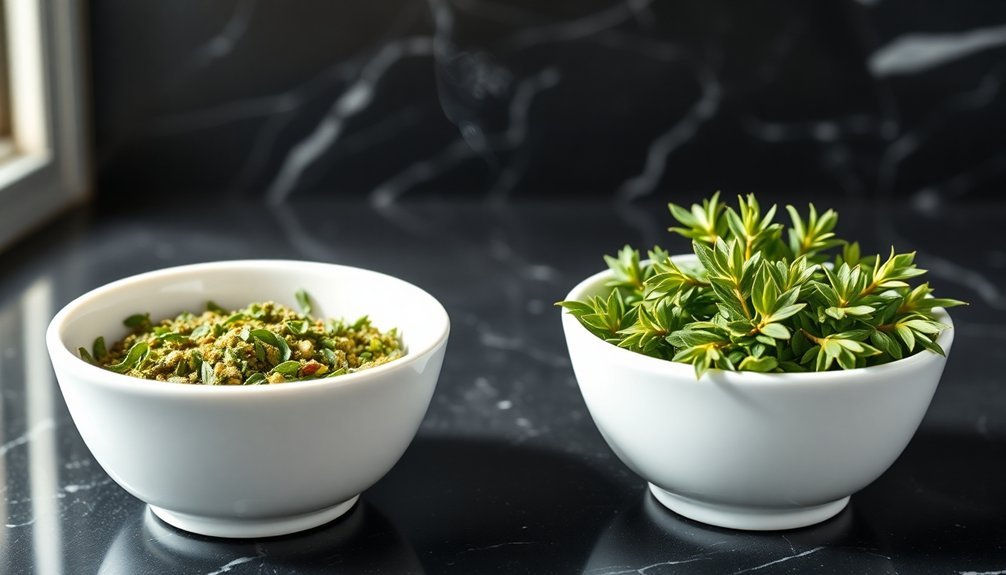
When testing dried herbs, you'll need to focus on established taste testing standards to accurately evaluate potency and quality.
You can assess both distinctive flavors and mouthfeel against reference samples, noting characteristics like bitterness, sweetness, or astringency.
The aroma intensity evaluation requires you to compare the herb's scent strength and character with known samples, paying attention to specific aromatic compounds that indicate freshness and therapeutic potential.
Taste Testing Standards
Testing the sensory profile of dried herbs requires standardized methods to secure reliable results. When you're comparing dried herbs to fresh ones, you'll need to follow specific testing protocols and utilize appropriate sensory evaluation techniques.
For reliable herb strength testing, you should implement these core standards:
- Select the right test format – Triangle tests work best for detecting subtle differences between dried and fresh herbs, while ranking tests are more suitable for comparing multiple samples of dried herbs for overall strength.
- Prepare your panel carefully – Train at least 10-30 panelists (depending on test type) and make sure they're familiar with herb characteristics. Don't exceed six samples per session to prevent sensory fatigue.
- Control testing conditions – Randomize sample presentation order, use blind coding, and maintain consistent environmental conditions like temperature and lighting.
- Document and analyze properly – Use standardized evaluation forms, collect detailed observations, and apply appropriate statistical methods to determine significant differences between samples.
You'll need to adjust your panel size based on your chosen test method: 8-50 for triangle tests, minimum 10 for duo-trio tests, and at least 30 for ranking or paired comparison tests.
Aroma Intensity Evaluation
Since dried herbs can lose considerable aromatic compounds during processing, evaluating their aroma intensity requires multiple sensory assessment methods. You'll need to assess both the sensory aspects and chemical composition to determine the herb's aromatic strength accurately.
Begin by conducting a simple aroma comparison test. Take your dried herb sample and compare it to a fresh control sample or a known high-quality dried standard. You'll want to detect any considerable differences in intensity and quality using duo-trio or ranking tests. Pay attention to specific notes that might be missing or diminished.
To get more detailed results, examine the physical condition of the herbs. Look for intact trichomes and oil glands, as these structures house essential oils. If you're working with a testing facility, you can request essential oil composition analysis to identify specific compounds and their concentrations.
Remember that drying temperature considerably impacts aroma retention. If you're evaluating commercially dried herbs, consider how the drying method may have affected the final product.
Higher drying temperatures typically result in greater loss of volatile compounds, while gentle air-drying better preserves aromatic qualities.
Antioxidant Activity Testing
The science of measuring antioxidant activity in dried herbs relies on several well-established laboratory methods. You'll find that these tests provide precise measurements of a herb's antioxidant capacity, helping you understand its potential health benefits and quality.
The most common tests use specific compounds to measure antioxidant strength. The DPPH assay measures radical scavenging activity at 517 nm, while the ABTS test evaluates antioxidant capacity at 734 nm. You can compare results using Trolox equivalents, making it easier to assess different herbs' relative strengths.
- DPPH Test: Measures how well herbs can neutralize free radicals, with results shown as radical scavenging activity.
- ABTS Assay: Determines antioxidant capacity by measuring the reduction of colored ABTS radical.
- FRAP Analysis: Evaluates the herb's ability to reduce ferric ions, correlating with total phenolic content.
- Total Phenolic Content: Uses the Folin-Ciocalteu method to measure overall phenolic compounds.
You'll typically find that dried herbs show higher antioxidant activity than fresh ones, especially when oven-dried.
Marjoram, basil, and mint consistently demonstrate strong antioxidant properties, while fennel shows comparatively lower activity.
Frequently Asked Questions
Does Freeze-Drying Affect the Medicinal Properties of Herbs Differently Than Air-Drying?
Yes, freeze-drying better preserves your herbs' medicinal properties. You'll retain more bioactive compounds, essential oils, and volatile substances compared to air-drying, which can degrade these components through heat exposure.
How Long Can Dried Herbs Maintain Their Full Potency After Processing?
You'll find that most dried herbs maintain their full potency for 6-12 months when stored properly. Ground herbs lose strength faster, while whole dried herbs and spices can retain potency for up to 3 years.
Can Different Harvest Seasons Affect the Strength of the Same Herb?
Yes, you'll notice significant strength variations in herbs harvested across different seasons. Summer and spring typically yield stronger herbs due to ideal sunlight and growing conditions, while winter harvests are often less potent.
What Role Does Altitude During Growing Play in Final Herb Potency?
You'll find herbs grown at higher altitudes often have increased potency due to environmental stress. The intense UV radiation, harsh climate, and extreme conditions trigger plants to produce more concentrated bioactive compounds for survival.
Do Wild-Harvested Herbs Typically Show Higher Strength Than Cultivated Varieties?
Yes, you'll typically find wild-harvested herbs show greater strength than cultivated ones. They develop higher levels of active ingredients due to natural stresses, competition, and slower growth in challenging environmental conditions.
In Summary
You've learned reliable methods to evaluate your dried herbs' potency and quality. By combining visual, tactile, and sensory tests, you'll know exactly what's in your spice cabinet. Don't forget to trust your senses – if the color's dull, aroma's weak, or texture's off, it's time for fresh herbs. With these testing techniques, you're now equipped to maintain an effective herb collection for your culinary and wellness needs.

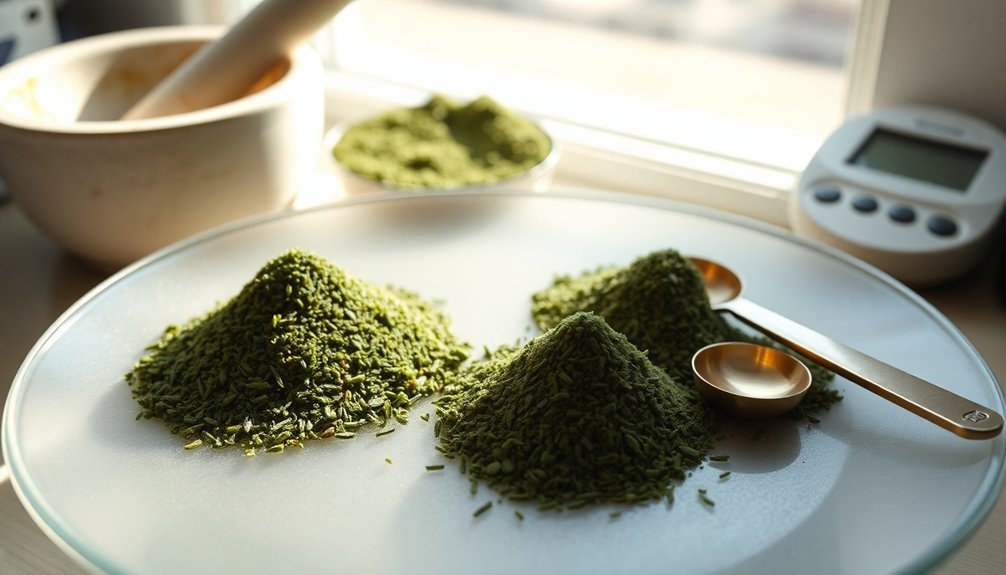



Leave a Reply